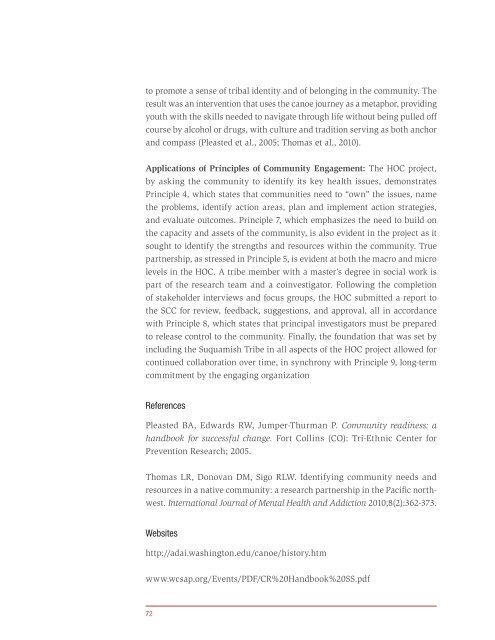Principles of Community Engagement (Second Edition)
Principles of Community Engagement (Second Edition)
Principles of Community Engagement (Second Edition)
You also want an ePaper? Increase the reach of your titles
YUMPU automatically turns print PDFs into web optimized ePapers that Google loves.
to promote a sense <strong>of</strong> tribal identity and <strong>of</strong> belonging in the community The<br />
result was an intervention that uses the canoe journey as a metaphor, providing<br />
youth with the skills needed to navigate through life without being pulled <strong>of</strong>f<br />
course by alcohol or drugs, with culture and tradition serving as both anchor<br />
and compass (Pleasted et al , 2005; Thomas et al , 2010)<br />
Applications <strong>of</strong> <strong>Principles</strong> <strong>of</strong> <strong>Community</strong> <strong>Engagement</strong>: The HOC project,<br />
by asking the community to identify its key health issues, demonstrates<br />
Principle 4, which states that communities need to “own” the issues, name<br />
the problems, identify action areas, plan and implement action strategies,<br />
and evaluate outcomes Principle 7, which emphasizes the need to build on<br />
the capacity and assets <strong>of</strong> the community, is also evident in the project as it<br />
sought to identify the strengths and resources within the community True<br />
partnership, as stressed in Principle 5, is evident at both the macro and micro<br />
levels in the HOC A tribe member with a master’s degree in social work is<br />
part <strong>of</strong> the research team and a coinvestigator Following the completion<br />
<strong>of</strong> stakeholder interviews and focus groups, the HOC submitted a report to<br />
the SCC for review, feedback, suggestions, and approval, all in accordance<br />
with Principle 8, which states that principal investigators must be prepared<br />
to release control to the community Finally, the foundation that was set by<br />
including the Suquamish Tribe in all aspects <strong>of</strong> the HOC project allowed for<br />
continued collaboration over time, in synchrony with Principle 9, long-term<br />
commitment by the engaging organization<br />
References<br />
Pleasted BA, Edwards RW, Jumper-Thurman P <strong>Community</strong> readiness: a<br />
handbook for successful change. Fort Collins (CO): Tri-Ethnic Center for<br />
Prevention Research; 2005<br />
Thomas LR, Donovan DM, Sigo RLW Identifying community needs and<br />
resources in a native community: a research partnership in the Pacific northwest<br />
International Journal <strong>of</strong> Mental Health and Addiction 2010;8(2):362-373<br />
Websites<br />
http://adai washington edu/canoe/history htm<br />
www wcsap org/Events/PDF/CR%20Handbook%20SS pdf<br />
72

















